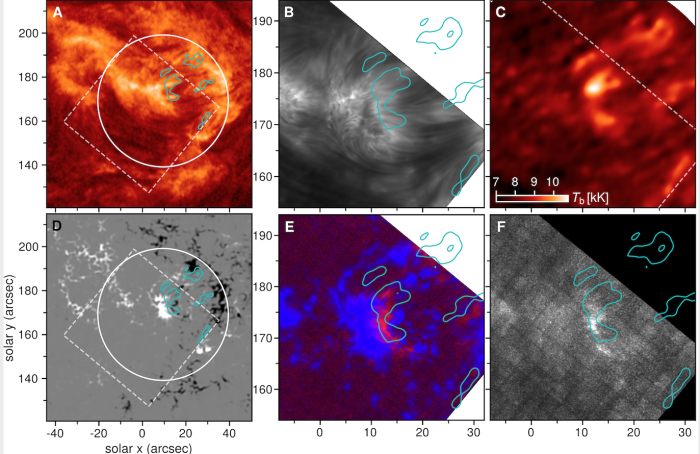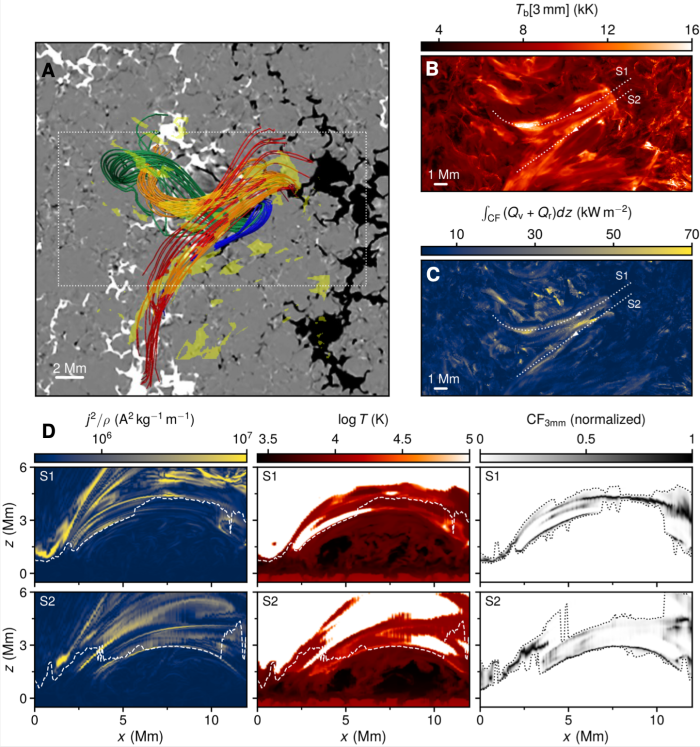Probing chromospheric current sheets using SST and ALMA co-observations
| Nugget | |
|---|---|
| Number: | 427 |
| 1st Author: | João da SILVA SANTOS |
| 2nd Author: | |
| Published: | 21 February 2021 |
| Next Nugget: | |
| Previous Nugget: | A demonstration of STIX hard X-ray imaging spectroscopy capabilities for an X-class flare (SOL2021-10-28) |
Introduction
Active regions (AR) are sites of enhanced emergence of magnetic flux from the convection zone into the solar atmosphere, and they appear generally brighter than the quiet Sun in chromospheric and transition region spectral diagnostics. They are also the garden in which hot coronal loops take root, and solar flares flower. While the relationship between radiative energy losses and magnetic field strength has been shown to be nonlinear, it is well-established that the magnetic field plays a role in amplifying the heating rates, for example by means of dissipation of magnetohydrodynamic wave energy or via [https://en.wikipedia.org/wiki/Magnetic_reconnection magnetic reconnection.
Although the temperature of the corona is orders of magnitude higher than that of the chromosphere, the heating requirements of the latter are greater because of the higher density. However, modeling the chromosphere is not trivial; it requires complex models and tools from MHD simulations to advanced data inversion techniques in order to interpret observations [1].
Our recent work [2] presents observations and modeling of optical and infrared spectropolarimetry taken by the CRISP instrument at the 1-m Swedish Solar Telescope (SST) and brightness-temperature (Tb) maps of the (thermal) 3 mm continuum obtained by ALMA. SDO provides extreme-UV (EUV) context imagery and photospheric magnetograms. The goal was to investigate the magnetic topology of a region of enhanced mm brightness in an active regino and estimate spatially resolved energy losses using inversion methods for comparison with simulations.
== An active region simultaneously observed in the EUV, optical, infrared, and mm ranges ==
Our multiwavelength dataset provides a unique opportunity to investigate the interplay between the magnetic topology and enhanced energy losses in the chromosphere. We find significant linear polarization signals in the photosphere and chromosphere between two patches of opposite magnetic polarity in the photosphere (Fig. 1). This is also the location of short bright fibrils seen in the core of the Ca II 8542 Å line underneath an arch-filament system best visible as absorption features in hotter AIA channels. We observed recurring elongated brightenings in the 3 mm continuum and in the AIA/304 Å passband throughout the observing campaign. A previous study found a good correlation between EUV and mm emission in AR transients and suggested that magnetic reconnection could explain at least some of them based on comparisons with simulations [3].

The low-lying loops meet the arch-filament system
Here we take advantage of the SST spectropolarimetry to derive a high-resolution photospheric vector magnetogram that we combine with a SDO/HMI vector magnetogram as an input for a magnetohydrostatic extrapolation [6]. From the comparison of the magnetic field structure and the distribution of ALMA 3 mm brightness temperature, we conclude that heating in current sheets likely occurs where the two flux systems meet at an angle (Fig. 2), which raises Tb following the enhancement of electron/proton densities. However, this is not straightforward to demonstrate given the expected significant variations in formation height of the mm continuum.
Simulating flux emergence and the emerging mm continuum brightness
We compared the observations to a snapshot of a 3D radiative-MHD simulation performed with the MURaM code [5] in order to gain further insight into the flux emergence process. The run is data-inspired in that we introduced magnetic flux that emerges into a preexisting magnetic canopy, mimicking the observations. This leads to multiple reconnection events and heating, which translates into both compact brightenings and very fine bright strands in the 3 mm continuum that are not fully resolved in the observed ALMA maps (Fig. 3). Analysis of the opacity data reveals the complex formation of this radiation - multiple current strands along the line-of-sight may contribute to the observed emission, which makes it harder to diagnose the source of heating based on the observed 3 mm brightness alone. Locations where temperature rises above 105 K do not significantly contribute to the mm opacity, but they could lead to TR brightenings.

Height-integrated radiative losses in the strongest chromospheric lines can be an order of magnitude higher than the ones inferred from the observations using the STiC code [4] but degrading the former to the ALMA spatial resolution (~1.2 arcsec) provides a good agreement between the two. We find mean values of 6(+-2) kW/m2 within the layers that contribute to the emission at 3 mm.
Conclusions
Our results provide evidence for heating in current sheets where small-scale, low-lying loops interact with the overlying chromospheric canopy as revealed by the textbook magnetic configuration inferred from the MHS extrapolation. The simulation reproduces the estimated radiative cooling rates and shows how flux emergence gives rise to the observed spectra
References
[1] "New View of the Solar Chromosphere"
[2] "ALMA observations of transient heating in a solar active region"
[3] "Heating of the solar chromosphere through current dissipation"
[4] "On the Extrapolation of Magnetohydrostatic Equilibria on the Sun"
[5] "Extension of the MURaM Radiative MHD Code for Coronal Simulations"
[6] "On the Extrapolation of Magnetohydrostatic Equilibria on the Sun"
